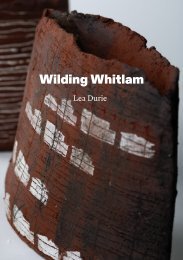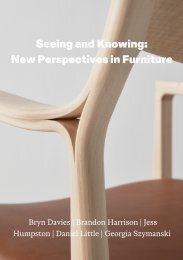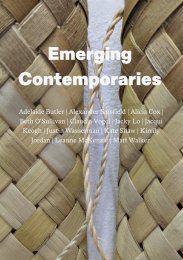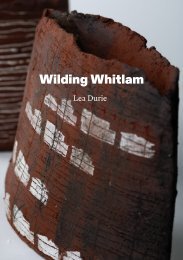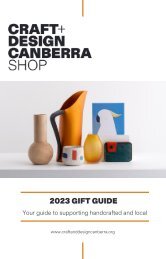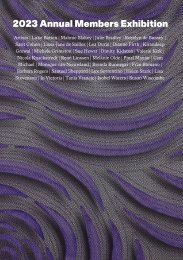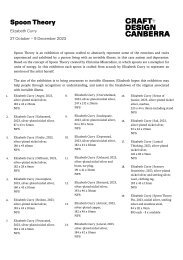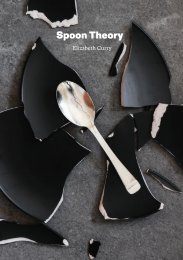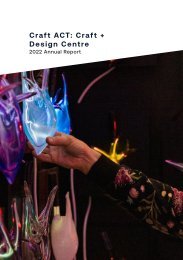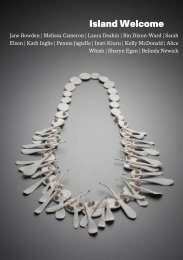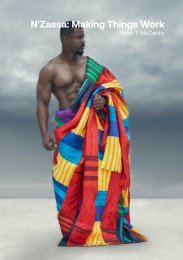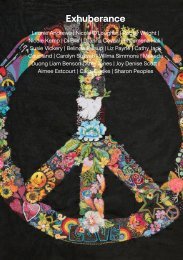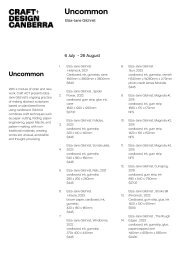Craft ACT Artist-in-residence 2014: Bogs and Fens
Sally Blake, Annee Miron and Satoshi Fujinama
Sally Blake, Annee Miron and Satoshi Fujinama
- No tags were found...
You also want an ePaper? Increase the reach of your titles
YUMPU automatically turns print PDFs into web optimized ePapers that Google loves.
craft + design centre<br />
<strong>Bogs</strong> <strong>and</strong> <strong>Fens</strong>:<br />
artist-<strong>in</strong>-<strong>residence</strong>
Residencies<br />
<strong>Artist</strong>s<br />
Satoshi Fuj<strong>in</strong>uma, Japan<br />
Sally Blake, Canberra<br />
Location: Gudgenby Ready-Cut Cottage,<br />
Namadgi National Park<br />
Annee Miron, Melbourne<br />
Location: Nil Desper<strong>and</strong>um Homestead,<br />
Tidb<strong>in</strong>billa Nature Reserve<br />
Dates<br />
Satoshi Fuj<strong>in</strong>uma: 1 Sept – 2 October <strong>2014</strong><br />
Annee Miron: 2 April – 14 May <strong>2014</strong><br />
Sally Blake: 7 April – 14 May <strong>2014</strong><br />
Research<br />
Australian National Botanic Gardens<br />
Exhibition<br />
Date: 10 April to 16 May 2015<br />
Location: <strong>Craft</strong> <strong>ACT</strong>: <strong>Craft</strong> + Design<br />
Centre Gallery<br />
Date: 24 April – 25 May 2015<br />
Location: Australian National Botanic<br />
Gardens, Visitor Centre Gallery<br />
Catalogue<br />
Public Program<br />
Open days at Nil Desper<strong>and</strong>um Homestead,<br />
Tidb<strong>in</strong>billa Nature Reserve <strong>and</strong> Gudgenby<br />
Ready-Cut Cottage, Namadgi National Park<br />
<strong>Artist</strong> talks at Australian National University<br />
Art Forum School of Art, <strong>and</strong> Australian<br />
National Botanic Gardens<br />
Workshops – Learn how to extract dyes<br />
from plants <strong>and</strong> then dye your own fabric<br />
with Sally Blake <strong>and</strong> Learn weav<strong>in</strong>g, plait<strong>in</strong>g<br />
<strong>and</strong> knott<strong>in</strong>g techniques <strong>and</strong> patterns to<br />
construct an object or plant form with your<br />
dyed fabric with Annee Miron, Australian<br />
National Botanic Gardens; <strong>and</strong> Naturalistic<br />
Wood Carv<strong>in</strong>g Intensive Weekend Workshop<br />
with Satoshi Fuj<strong>in</strong>uma, Australian National<br />
University School of Art Furniture Workshop<br />
Forum – <strong>Bogs</strong> <strong>and</strong> <strong>Fens</strong>: the <strong>in</strong>terplay<br />
between craft, science <strong>and</strong> the environment,<br />
Australian National Botanic Gardens<br />
Introduction<br />
Avi Amesbury 3<br />
Alp<strong>in</strong>e bogs <strong>and</strong> fens – wetl<strong>and</strong>s of significance<br />
Brett McNamara 7<br />
Bog <strong>and</strong> fens: <strong>2014</strong> artists-<strong>in</strong>-<strong>residence</strong><br />
Judy West 9<br />
Catalogue essay<br />
What word is that? <strong>Bogs</strong>, fens <strong>and</strong> how we underst<strong>and</strong> them<br />
Rosanna Stevens 11<br />
From the artists<br />
Satoshi Fuj<strong>in</strong>uma 17<br />
Annee Miron 19<br />
Sally Blake 20<br />
Public program<br />
Forum 23<br />
Speaker biographies 24<br />
Acknowledgements 28
<strong>Bogs</strong> <strong>and</strong> <strong>Fens</strong>: a rtist-<strong>in</strong>-<strong>residence</strong><br />
Introduction<br />
<strong>Craft</strong>, science <strong>and</strong> the environment<br />
It is n<strong>in</strong>e years s<strong>in</strong>ce the <strong>in</strong>itial<br />
conversation between <strong>Craft</strong> <strong>ACT</strong>: <strong>Craft</strong><br />
<strong>and</strong> Design Centre <strong>and</strong> <strong>ACT</strong> Parks &<br />
Conservation Service, <strong>and</strong> the <strong>in</strong>augural<br />
<strong>Artist</strong>-<strong>in</strong>-Residence program. Over the<br />
years the program has grown from<br />
host<strong>in</strong>g local artists to attract<strong>in</strong>g national<br />
<strong>and</strong> <strong>in</strong>ternational practitioners. In 2013<br />
the program exp<strong>and</strong>ed to <strong>in</strong>corporate a<br />
research component, with artists be<strong>in</strong>g<br />
<strong>in</strong>vited to undertake a research period <strong>in</strong><br />
a national cultural or research <strong>in</strong>stitution.<br />
Open days <strong>in</strong> the Parks, artists’ talks,<br />
workshops <strong>and</strong> forums are held dur<strong>in</strong>g<br />
the residencies so that the community<br />
can meet the artists <strong>and</strong> engage through<br />
the public program. The <strong>residence</strong> draws<br />
attention to Canberra’s dist<strong>in</strong>ct natural<br />
<strong>and</strong> cultural l<strong>and</strong>scape <strong>and</strong> connects<br />
community to our unique environment.<br />
This was particularly poignant <strong>in</strong><br />
<strong>2014</strong> with the selected artists, Satoshi<br />
Fuj<strong>in</strong>uma, Sally Blake <strong>and</strong> Annee Miron,<br />
<strong>in</strong>vited to respond to the theme the<br />
environmental protection of bogs<br />
<strong>and</strong> fens. The devastat<strong>in</strong>g bushfires <strong>in</strong><br />
2003 affected all the bogs <strong>in</strong> Namadgi<br />
National Park <strong>and</strong> a collaborative<br />
restoration program between <strong>ACT</strong> Parks<br />
& Conservation Service <strong>and</strong> the Australian<br />
National Botanic Gardens was undertaken<br />
to aid their recovery. Bog communities<br />
provide a number of ecosystem services<br />
<strong>in</strong>clud<strong>in</strong>g the breed<strong>in</strong>g habitat for the<br />
endangered Corroboree frogs as well as<br />
water control <strong>and</strong> filtration at catchment<br />
sources. Canberra’s water catchment area<br />
is <strong>in</strong> Namadgi National Park.<br />
It seemed a perfect match for a<br />
three‐way partnership – <strong>Craft</strong> <strong>ACT</strong>,<br />
<strong>ACT</strong> Parks & Conservation Service<br />
<strong>and</strong> the Australian National Botanic<br />
Gardens – with the artists undertak<strong>in</strong>g<br />
their residency at Gudgenby Ready‐Cut<br />
Cottage <strong>in</strong> Namadgi National Park<br />
<strong>and</strong> Nil Desper<strong>and</strong>um Homestead <strong>in</strong><br />
Tidb<strong>in</strong>billa Nature Reserve, <strong>and</strong> their<br />
research period at the Gardens.<br />
The Gardens facilitated field trips to the<br />
bogs <strong>and</strong> fens <strong>in</strong> the national park, <strong>and</strong><br />
gave the artists open access to scientists,<br />
their research data <strong>and</strong> equipment.<br />
The assistance <strong>and</strong> generosity of the<br />
partners has had a deep <strong>and</strong> last<strong>in</strong>g<br />
impact on everyone <strong>in</strong>volved – artists,<br />
scientists, rangers, <strong>and</strong> the public – <strong>and</strong><br />
provided unique opportunities to l<strong>in</strong>k<br />
ideas, knowledge <strong>and</strong> creativity.<br />
The artists’ isolation <strong>and</strong> immersion <strong>in</strong><br />
the residency gave way to self-reflection,<br />
<strong>in</strong>sights <strong>in</strong>to a culture <strong>and</strong> nature of<br />
Cover: Swamp, Barr<strong>in</strong>gton Tops. Photography, Murray Fagg. Image provided by the Australian National Botanic Gardens.<br />
Inside cover: Satoshi Fuj<strong>in</strong>uma, captur<strong>in</strong>g the l<strong>and</strong>scape for future reference, Gudgenby Ready-Cut Cottage, Namadgi<br />
National Park. Photography: Art Atelier Photography.<br />
Left: Swampl<strong>and</strong>. Photography, Murray Fagg. Image provided by the Australian National Botanic Gardens.<br />
PAGE 3
thoughtless destructiveness, <strong>and</strong> the<br />
discovery of new ways of see<strong>in</strong>g, <strong>and</strong>,<br />
perhaps chang<strong>in</strong>g. It challenged ideas of<br />
aloneness, <strong>in</strong>tellectual underst<strong>and</strong><strong>in</strong>g of<br />
how natural ecosystem work <strong>and</strong> the vital<br />
role they play <strong>in</strong> our world.<br />
Each year the residency draws together<br />
people of different ideals <strong>and</strong> cultures,<br />
<strong>and</strong> touches their hearts. Through a<br />
shared passion – art, science or the<br />
environment – we are taken on a journey<br />
of change, of new ways of see<strong>in</strong>g <strong>and</strong><br />
a deeper underst<strong>and</strong><strong>in</strong>g of the l<strong>and</strong><br />
we are custodians of.<br />
Avi Amesbury<br />
Executive Director<br />
<strong>Craft</strong> <strong>ACT</strong>: <strong>Craft</strong> <strong>and</strong> Design Centre<br />
Residencies: Memories <strong>in</strong> Place: art <strong>in</strong> high<br />
country huts, artists Paull McKee, Daniel<br />
Mag<strong>in</strong>nity <strong>and</strong> Joanne Searle; <strong>Artist</strong>s <strong>in</strong><br />
place: Gudgenby Ready-Cut Cottage<br />
Residency, artists Paull McKee <strong>and</strong> Kirstie<br />
Rea; Talk<strong>in</strong>g Water: artists-<strong>in</strong>-<strong>residence</strong>,<br />
artists Antonia Aitken, Christ<strong>in</strong>e Atk<strong>in</strong>s,<br />
Marily C<strong>in</strong>tra <strong>and</strong> Marian Hosk<strong>in</strong>g;<br />
Elements of Place: artist-<strong>in</strong>-<strong>residence</strong>,<br />
artists Michael Brenn<strong>and</strong>-Wood (UK)<br />
<strong>and</strong> Ceretha Sk<strong>in</strong>ner, Gumbayngirr<br />
woman; <strong>and</strong> most recently <strong>Bogs</strong> <strong>and</strong><br />
<strong>Fens</strong>: artist-<strong>in</strong>-<strong>residence</strong>, artists Satoshi<br />
Fuj<strong>in</strong>uma (Japan), Sally Blake <strong>and</strong><br />
Annee Miron.<br />
PAGE 4<br />
Above: Visitors listen<strong>in</strong>g to presentations at the artist-<strong>in</strong>-<strong>residence</strong> open day, Gudgenby Ready-Cut Cottage,<br />
Namadgi National Park. Photography: Art Atelier Photography<br />
Right: Map of Namadgi National Park.
To Tumut<br />
Br<strong>in</strong>dabella Rd<br />
Cotter Rd<br />
CANBERRA<br />
BendoraR<br />
Mt Frankl<strong>in</strong> Rd<br />
d<br />
NAMADGI<br />
TIDBINBILLA<br />
NATURE<br />
RESERVE<br />
NATIONAL<br />
Cor<strong>in</strong> Rd<br />
Apollo<br />
Tidb<strong>in</strong>billa Rd<br />
Rd<br />
Tharwa<br />
Naas Rd<br />
Namadgi<br />
Visitor<br />
Centre<br />
Orroral Rd<br />
PARK<br />
Boboyan Rd<br />
Gudgenby<br />
Ready-Cut Cottage<br />
0<br />
10km<br />
NSW<br />
<strong>ACT</strong><br />
25 km<br />
To Adam<strong>in</strong>aby
<strong>Bogs</strong> <strong>and</strong> <strong>Fens</strong>: a rtist-<strong>in</strong>-<strong>residence</strong><br />
Alp<strong>in</strong>e bogs <strong>and</strong> fens –<br />
wetl<strong>and</strong>s of significance<br />
The <strong>Artist</strong>-<strong>in</strong>-Residence program has to<br />
date produced a rich repertoire of cultural<br />
practice, born from a direct association<br />
with the majestic mounta<strong>in</strong>s of Namadgi<br />
National Park.<br />
This diverse body of work now provides<br />
us with an archive of imag<strong>in</strong>ative<br />
<strong>in</strong>terpretation. It speaks of artistic<br />
<strong>in</strong>terpretation that has created a narrative<br />
for discussion, discourse <strong>and</strong> debate.<br />
Through this, we are offered <strong>in</strong>sights<br />
<strong>in</strong>to the many stories of this ancient,<br />
yet constantly evolv<strong>in</strong>g l<strong>and</strong>scape.<br />
Here <strong>in</strong> the Bush Capital we f<strong>in</strong>d ourselves<br />
immersed by nature’s artistic endeavours.<br />
The ancient mounta<strong>in</strong>s which surround<br />
the nation’s capital shape our urban<br />
existence on so many different levels.<br />
The mounta<strong>in</strong>s <strong>and</strong> valleys are a place<br />
of beauty, where nature is able to flourish<br />
<strong>and</strong> evolve, where clear water flows <strong>and</strong><br />
where people can f<strong>in</strong>d <strong>in</strong>sight, enjoyment<br />
<strong>and</strong> underst<strong>and</strong><strong>in</strong>g.<br />
It was set aga<strong>in</strong>st this backdrop that<br />
a catalyst for a rather unique alliance<br />
between the <strong>ACT</strong> Parks & Conservation<br />
Service <strong>and</strong> <strong>Craft</strong> <strong>ACT</strong> formed. Now <strong>in</strong><br />
its n<strong>in</strong>th year, this partnership cont<strong>in</strong>ues<br />
to weave a rich tapestry of artistic<br />
<strong>in</strong>terpretation of our natural world.<br />
In <strong>2014</strong>, the theme for the <strong>Artist</strong>-<strong>in</strong>-<br />
Residence program spoke of the<br />
significance of environmental wetl<strong>and</strong>s.<br />
Alp<strong>in</strong>e wetl<strong>and</strong>s purify <strong>and</strong> replenish our<br />
water. Alp<strong>in</strong>e wetl<strong>and</strong>s act as a natural<br />
sponge aga<strong>in</strong>st flood<strong>in</strong>g <strong>and</strong> drought <strong>and</strong><br />
protect our fragile mounta<strong>in</strong>s ecosystems.<br />
They burst with biodiversity <strong>and</strong> are a<br />
vital means of stor<strong>in</strong>g carbon. Put simply,<br />
the future of humanity depends on our<br />
fragile wetl<strong>and</strong>s.<br />
The three artists, Sally Blake, Annee<br />
Miron <strong>and</strong> Satoshi Fuj<strong>in</strong>uma immersed<br />
themselves <strong>in</strong> this primordial l<strong>and</strong>scape<br />
<strong>and</strong> <strong>in</strong>terpreted the environmental values<br />
of alp<strong>in</strong>e bogs <strong>and</strong> fens – unique <strong>and</strong><br />
endangered peat-form<strong>in</strong>g wetl<strong>and</strong>s which<br />
occur <strong>in</strong> cool, wet mounta<strong>in</strong>ous environs<br />
across Australia’s high country.<br />
These unique communities provide<br />
a number of ecosystem services<br />
<strong>in</strong>clud<strong>in</strong>g vital breed<strong>in</strong>g habitats for the<br />
critically endangered Corroboree frog<br />
(Pseudophryne sp.) as well as water<br />
control <strong>and</strong> filtration at catchment<br />
sources. Worldwide, wetl<strong>and</strong>s are<br />
threatened by a number of processes<br />
such as climate change. In the Australian<br />
Alps high country, alp<strong>in</strong>e bogs are also<br />
impacted by the heavy hoof graz<strong>in</strong>g by<br />
cattle <strong>and</strong> thous<strong>and</strong>s of feral horses.<br />
Left: Sphagnum Swamp, Monga. Photography, Murray Fagg.<br />
Image provided by the Australian National Botanic Gardens.<br />
PAGE 7
Increas<strong>in</strong>gly, fire frequency can a have<br />
a devastat<strong>in</strong>g impact as was the case <strong>in</strong><br />
2003, when major wildfires impacted <strong>and</strong><br />
destroyed many alp<strong>in</strong>e bogs. While based<br />
at Namadgi National Park <strong>and</strong> Tidb<strong>in</strong>billa<br />
Nature Reserve, <strong>and</strong> dur<strong>in</strong>g research at<br />
the Australian National Botanic Gardens,<br />
the artists explored <strong>and</strong> <strong>in</strong>terpreted<br />
<strong>in</strong>itiatives aimed to conserve <strong>and</strong> enhance<br />
these endangered communities.<br />
<strong>Bogs</strong> <strong>and</strong> <strong>Fens</strong>: artist-<strong>in</strong>-<strong>residence</strong> is<br />
without equal with<strong>in</strong> this environmental<br />
sett<strong>in</strong>g. Contribut<strong>in</strong>g to the broader<br />
conversation, it captures this unique<br />
l<strong>and</strong>scape as be<strong>in</strong>g one of outst<strong>and</strong><strong>in</strong>g<br />
natural significance to the national capital,<br />
the city <strong>and</strong> people of Canberra.<br />
Brett McNamara<br />
Regional Manager<br />
National Parks <strong>and</strong> Catchments Region<br />
<strong>ACT</strong> Parks & Conservation Service<br />
Above: Annee Miron talk<strong>in</strong>g about her prelim<strong>in</strong>ary work <strong>and</strong> her <strong>in</strong>spiration, artist-<strong>in</strong>-<strong>residence</strong> open day,<br />
Nil Desper<strong>and</strong>um Homestead, Tidb<strong>in</strong>billa Nature Reserve. Photography, Art Atelier Photography.<br />
PAGE 8
<strong>Bogs</strong> <strong>and</strong> <strong>Fens</strong>: a rtist-<strong>in</strong>-<strong>residence</strong><br />
<strong>Bogs</strong> <strong>and</strong> <strong>Fens</strong>:<br />
<strong>2014</strong> artists-<strong>in</strong>-<strong>residence</strong><br />
The theme ‘bogs <strong>and</strong> fens’ for the <strong>2014</strong><br />
<strong>Craft</strong> <strong>ACT</strong> <strong>Artist</strong>s-<strong>in</strong>-Residence program<br />
is a significant research area at the<br />
Australian National Botanic Gardens.<br />
Locally, these unique <strong>and</strong> endangered<br />
peat-form<strong>in</strong>g wetl<strong>and</strong>s provide a number<br />
of ecosystem services <strong>in</strong>clud<strong>in</strong>g breed<strong>in</strong>g<br />
habitat for endangered Corroboree frogs<br />
<strong>and</strong> water control <strong>and</strong> filtration. Our<br />
research at the Gardens, <strong>in</strong>vestigat<strong>in</strong>g<br />
how seeds <strong>in</strong> these communities persist<br />
<strong>and</strong> germ<strong>in</strong>ate, contributes to our<br />
underst<strong>and</strong><strong>in</strong>g of plant survival <strong>and</strong><br />
succession <strong>in</strong> bogs <strong>and</strong> fens.<br />
<strong>Artist</strong>s <strong>and</strong> scientists approach issues<br />
<strong>in</strong> similar ways – both are <strong>in</strong>quisitive<br />
ask<strong>in</strong>g the questions ‘why’ <strong>and</strong> ‘how’ <strong>and</strong><br />
th<strong>in</strong>k<strong>in</strong>g ‘outside the square’ to solve<br />
problems or create artwork. Despite this<br />
similarity <strong>in</strong> approach<strong>in</strong>g an issue, their<br />
observations of the natural world may<br />
be very different. <strong>Artist</strong>s can view the<br />
natural world from different perspectives.<br />
Scientists are aware of the fragile <strong>and</strong><br />
endangered nature of bogs <strong>and</strong> fens <strong>and</strong><br />
express this through their research. An<br />
artist can express the fragility of these<br />
ecosystems with a small, ‘simple’ <strong>in</strong>tricate<br />
woven basket from plants grow<strong>in</strong>g <strong>in</strong><br />
these ecosystems.<br />
An artist’s <strong>in</strong>terpretation of a<br />
subject or issue assists scientists<br />
with communicat<strong>in</strong>g it to the public.<br />
Communicat<strong>in</strong>g our scientific research<br />
is a key goal of the Gardens. This is one<br />
of the strengths of the <strong>Craft</strong> <strong>ACT</strong> <strong>Artist</strong><strong>in</strong>-Residence<br />
program <strong>and</strong> a reason the<br />
Australian National Botanic Gardens is<br />
proud to support this program.<br />
To see one artist’s <strong>in</strong>terpretation of bogs<br />
<strong>and</strong> fens is <strong>in</strong>trigu<strong>in</strong>g – to see three artists,<br />
each work<strong>in</strong>g <strong>in</strong> a different medium, is<br />
eye-open<strong>in</strong>g.<br />
I thank Sally Blake, Annee Miron <strong>and</strong><br />
Satoshi Fuj<strong>in</strong>uma for their enthusiasm <strong>and</strong><br />
will<strong>in</strong>gness to share their <strong>in</strong>terpretation<br />
of bogs <strong>and</strong> fens, <strong>and</strong> for the will<strong>in</strong>gness<br />
to share their crafts with staff <strong>and</strong> public<br />
dur<strong>in</strong>g their residency at the Gardens. You<br />
each have brought a different perspective<br />
to one of our scientific challenges –<br />
underst<strong>and</strong><strong>in</strong>g <strong>and</strong> protect<strong>in</strong>g our<br />
endangered bogs <strong>and</strong> fens.<br />
Judy West<br />
Executive Director<br />
Australian National Botanic Gardens<br />
PAGE 9
<strong>Bogs</strong> <strong>and</strong> <strong>Fens</strong>: a rtist-<strong>in</strong>-<strong>residence</strong><br />
Catalogue essay<br />
What word is that?<br />
<strong>Bogs</strong>, fens <strong>and</strong> how we underst<strong>and</strong> them<br />
By Rosanna Stevens<br />
Aurally, ‘bog’ isn’t a particularly pleasant<br />
word. It’s squat <strong>and</strong> round at the front,<br />
monosyllabic, <strong>and</strong> the end of the<br />
word gets stuck <strong>in</strong> your throat – ‘bog’.<br />
Perhaps I take this view because <strong>in</strong><br />
modern Australia, the term connotes<br />
too many th<strong>in</strong>gs that are not specifically<br />
the ecology <strong>and</strong> state of a ‘wet, muddy<br />
ground too soft to support a heavy body’.<br />
‘Bog’ has always existed <strong>in</strong> my vernacular<br />
as either a figurative or slang term. In<br />
fact, I can’t recall a time where I sat <strong>in</strong> a<br />
classroom <strong>and</strong> was taught the gorgeous<br />
factual <strong>in</strong>tricacies of what a bog truly<br />
is, <strong>and</strong> how it functions. Similarly a ‘fen’<br />
is a monosyllabic term that for too long<br />
escaped me: soft, verdant <strong>and</strong> feathery<br />
<strong>in</strong> sound, the word never immediately<br />
summoned marsh or wetl<strong>and</strong>, because<br />
it summoned noth<strong>in</strong>g at all: it’s not<br />
a term we are encouraged to use <strong>in</strong><br />
pass<strong>in</strong>g conversation, unless perhaps<br />
we visited one recently on one of those<br />
marshl<strong>and</strong> holidays the tourism <strong>in</strong>dustry<br />
so commonly capitalises on.<br />
Recently, lead<strong>in</strong>g British nature writer<br />
Robert MacFarlane delved <strong>in</strong>to this<br />
change <strong>in</strong> awareness of environmental<br />
language <strong>in</strong> The Guardian. In draw<strong>in</strong>g to<br />
the public attention the loss of words<br />
that connote or describe our natural<br />
environment, he discussed the most<br />
recent edition of the Oxford Junior<br />
Dictionary, which has removed a list<br />
of nature-related terms – from acorn<br />
to willow – <strong>and</strong> replaced them with a<br />
technological lexicon. What does this<br />
loss mean? Are we forgett<strong>in</strong>g how to<br />
see <strong>and</strong> describe the very th<strong>in</strong>g that<br />
builds us <strong>and</strong> gives us life?<br />
For bogs <strong>and</strong> fens, while their exact<br />
mean<strong>in</strong>gs slowly eek from the Austral<br />
vernacular, their rich watery bodies lie<br />
patiently, still there, but <strong>in</strong>creas<strong>in</strong>gly<br />
threatened by exactly that which the<br />
Oxford Junior Dictionary has almost<br />
too poetically decided to replace<br />
environmental worlds with: human stuff.<br />
Alp<strong>in</strong>e Sphagnum <strong>Bogs</strong> <strong>and</strong> Associated<br />
<strong>Fens</strong> – those bogs <strong>and</strong> fens which<br />
specifically populate the <strong>ACT</strong> region,<br />
as well as outcrops <strong>in</strong> areas of southern<br />
New South Wales, Victoria <strong>and</strong> Tasmania<br />
– are complex ecosystems which act<br />
as significant habitats for a number of<br />
endemic plant species <strong>and</strong> threatened<br />
animals. Yet, due to their sporadic <strong>and</strong><br />
small geographic distribution, these<br />
Left: Annee Miron, Borrowed Time (detail), 2015, found cardboard <strong>and</strong> gouache.<br />
Photography: Brent Edwards.<br />
PAGE 11
Above: Sally Blake, Seed Baskets (detail) 2015, Plant dyed wool <strong>and</strong> silk, silver wire. Image courtesy of the artist.<br />
ecological communities are easily<br />
threatened due to exotic weeds, clear<strong>in</strong>g<br />
of l<strong>and</strong> for pasture work or residential<br />
development, sphagnum moss-<strong>in</strong>dustry<br />
(yes, really), erosion from livestock tread<br />
<strong>and</strong> graz<strong>in</strong>g, wildfires, <strong>and</strong> domestic<br />
human waste such as discarded rubbish.<br />
I recently discovered that to see a ‘before’<br />
<strong>and</strong> ‘after’ shot of a bog <strong>and</strong> fen system<br />
trampled by hard hoofed herds is – once<br />
you’ve appreciated the life-cradl<strong>in</strong>g role of<br />
the bog <strong>and</strong> fen – more unnerv<strong>in</strong>g for me<br />
than remember<strong>in</strong>g when my phone gave<br />
a f<strong>in</strong>al, personal-<strong>in</strong>formation-eclips<strong>in</strong>g<br />
w<strong>in</strong>k last year. I see this as a hopeful sign.<br />
To resurrect <strong>and</strong> reconnect the<br />
environment to the human conscience,<br />
MacFarlane, <strong>in</strong> his article, called for<br />
English language speakers to ‘re-wild’ our<br />
vernaculars. He asked readers to consider<br />
the beauty <strong>and</strong> environmental detail<br />
of old English, Welsh <strong>and</strong> Irish words.<br />
The most stunn<strong>in</strong>g example MacFarlane<br />
gave, of a word tied to a complex <strong>and</strong><br />
old environmental mean<strong>in</strong>g was the<br />
Gaelic, ‘èit’, which refers very exactly to<br />
“the practice of plac<strong>in</strong>g quartz stones <strong>in</strong><br />
streams so that they sparkle <strong>in</strong> moonlight<br />
<strong>and</strong> thereby attract salmon to them <strong>in</strong><br />
the late summer <strong>and</strong> autumn”.<br />
PAGE 12
<strong>Bogs</strong> <strong>and</strong> <strong>Fens</strong>: a rtist-<strong>in</strong>-<strong>residence</strong><br />
Here <strong>in</strong> Australia, I’m not particularly<br />
comfortable with the idea of ‘wild<strong>in</strong>g’ or<br />
‘wilderness<strong>in</strong>g’ anyth<strong>in</strong>g, because <strong>in</strong> a<br />
colonial context, wilderness has been a<br />
tool for separat<strong>in</strong>g ourselves from what<br />
humans supposedly cannot tame. In<br />
other<strong>in</strong>g ourselves from the l<strong>and</strong>scape<br />
we dismiss our responsibility to the<br />
l<strong>and</strong>. We also dismiss the first languages<br />
that describe the country we now live<br />
<strong>in</strong> custodianship of, with such ancient<br />
<strong>in</strong>timacy: languages that are as much<br />
about describ<strong>in</strong>g a bog or a fen as they<br />
are describ<strong>in</strong>g the human relationships<br />
<strong>and</strong> responsibilities to them.<br />
<strong>Craft</strong> <strong>ACT</strong> artist-<strong>in</strong>-<strong>residence</strong> Annee<br />
Miron, beautifully advocated for this<br />
connectedness we all have to the<br />
environment, <strong>and</strong> rem<strong>in</strong>ded me of the<br />
ways our language so easily unfurls<br />
to complement <strong>and</strong> draw close to our<br />
underst<strong>and</strong><strong>in</strong>g of an environmental idea.<br />
She observed:<br />
‘Adrian Brown, a Ngunnawal man, told<br />
me that <strong>in</strong> Ngunnawal country the alp<strong>in</strong>e<br />
bogs <strong>and</strong> fens “are the beg<strong>in</strong>n<strong>in</strong>g of<br />
everyth<strong>in</strong>g.” These acid-etched cataracts<br />
<strong>in</strong> the mounta<strong>in</strong> bushl<strong>and</strong> each hold <strong>and</strong><br />
slowly release vast volumes of water.<br />
Above: Satoshi Fuj<strong>in</strong>uma, seed series – Journey, 2015, sheoak, pa<strong>in</strong>t, lacquer. Image courtesy of the artist.<br />
PAGE 13
At ground level they are pla<strong>in</strong> look<strong>in</strong>g <strong>and</strong><br />
undramatic, though burst <strong>in</strong>to diversity,<br />
colour <strong>and</strong> life when explored up close<br />
<strong>and</strong> over time <strong>and</strong> with the knowledge<br />
shared by others: traditional owners,<br />
rangers, scientists <strong>and</strong> archaeologists.’<br />
Her portrait is sharp <strong>and</strong> visceral, an<br />
homage to the time spent learn<strong>in</strong>g <strong>in</strong><br />
<strong>and</strong> around Namadgi National Park,<br />
that her residency afforded her. And<br />
it is <strong>in</strong> her experience <strong>and</strong> reflection<br />
that we can beg<strong>in</strong> to consider how,<br />
<strong>in</strong> modern Australia, we can renature<br />
our vocabularies to grow more<br />
environmentally capable <strong>and</strong> aware. <strong>Craft</strong><br />
<strong>ACT</strong>’s artist-<strong>in</strong>-<strong>residence</strong> program offers<br />
us this most enjoyable <strong>and</strong> engag<strong>in</strong>g<br />
message: that we must give one another<br />
<strong>and</strong> ourselves opportunities to talk, make,<br />
<strong>and</strong> live with our environments more<br />
often than we already allow ourselves to.<br />
Through <strong>Craft</strong> <strong>ACT</strong>’s artist-<strong>in</strong>-<strong>residence</strong><br />
program, held <strong>in</strong> partnership with <strong>ACT</strong><br />
Parks & Conservation Service <strong>and</strong> the<br />
Australian National Botanic Gardens,<br />
three artists – Annee Miron, Sally Blake<br />
<strong>and</strong> Satoshi Fuj<strong>in</strong>uma – were <strong>in</strong>vited<br />
to spend a susta<strong>in</strong>ed period of time <strong>in</strong><br />
Namadgi National Park, <strong>and</strong> after some<br />
research, <strong>in</strong>terpret the theme of ‘the<br />
environmental protection of bogs <strong>and</strong><br />
fens’ <strong>in</strong> their mak<strong>in</strong>g. What these artists<br />
produced was a renatur<strong>in</strong>g of their<br />
creative <strong>and</strong> expressive vernaculars. They<br />
have produced work that <strong>in</strong>corporates<br />
traditional European, personal, cultural<br />
<strong>and</strong> contemporary <strong>in</strong>terpretations of<br />
these marshy ecosystems. Through<br />
their artistic languages of reflection <strong>and</strong><br />
creation, we are offered detailed <strong>and</strong><br />
diverse mean<strong>in</strong>gs for <strong>and</strong> <strong>in</strong>carnations<br />
of ‘bog’ <strong>and</strong> ‘fen’. These artists have<br />
made beautiful def<strong>in</strong>itions of nativeness<br />
Above: Sally Blake, The Ecological Thought (detail), 2015, Crocheted paper yarn. Image courtesy of the artist.<br />
PAGE 14
<strong>Bogs</strong> <strong>and</strong> <strong>Fens</strong>: a rtist-<strong>in</strong>-<strong>residence</strong><br />
<strong>and</strong> modern suffer<strong>in</strong>g, of fragility <strong>and</strong><br />
<strong>in</strong>terconnectedness articulated through<br />
sp<strong>in</strong>dl<strong>in</strong>g cardboard, <strong>and</strong> the robust<br />
life‐giv<strong>in</strong>g mechanisms presented <strong>in</strong> the<br />
form of seed-pods thick with colour.<br />
Miron, Blake <strong>and</strong> Fuj<strong>in</strong>uma have formed<br />
their own illustrative ecosystems of<br />
mean<strong>in</strong>g that connect, strengthen,<br />
<strong>and</strong> <strong>in</strong>terplay with one another on the<br />
exhibition floor. They have given us a<br />
modern dictionary from which to graft<br />
our own underst<strong>and</strong><strong>in</strong>g of bogs <strong>and</strong> fens.<br />
Moreover, their work rem<strong>in</strong>ds us that<br />
def<strong>in</strong>itions are, by nature (<strong>and</strong> <strong>in</strong> nature),<br />
multiplicit. Each piece celebrates the<br />
diversity of human that is welcomed by<br />
country: to relate to <strong>and</strong> <strong>in</strong>terpret it, so<br />
long as that environment or l<strong>and</strong>scape<br />
rema<strong>in</strong>s the creative message or priority.<br />
It is through this lens of environmental<br />
underst<strong>and</strong><strong>in</strong>g that artist-<strong>in</strong>-<strong>residence</strong><br />
Sally Blake cont<strong>in</strong>ually looks to,<br />
‘develop a deeper underst<strong>and</strong><strong>in</strong>g of<br />
the <strong>in</strong>terconnections between nature’s<br />
pattern <strong>and</strong> processes, <strong>and</strong> humans<br />
place <strong>in</strong> the whole.’ It is also through the<br />
language of environment that Japanese<br />
artist-<strong>in</strong>-<strong>residence</strong> Satoshi Fuj<strong>in</strong>uma<br />
can still draw on his passion for f<strong>in</strong>d<strong>in</strong>g<br />
an usual element of the l<strong>and</strong>scape that<br />
prompts him to ask, ‘how does that work,<br />
<strong>and</strong> why?’ <strong>and</strong> through environmental<br />
question<strong>in</strong>g can draw an environmentallyreflective<br />
answer <strong>and</strong> aesthetic.<br />
In form<strong>in</strong>g this creative bond to the<br />
environmental experience – whether<br />
as a maker or an exhibition patron –<br />
we are rem<strong>in</strong>ded that each of us has a<br />
responsibility to country. Each of us has<br />
our own connection to the <strong>in</strong>escapable<br />
ecosystems that make our place exactly<br />
what it is. We host our own ability to talk<br />
<strong>and</strong> th<strong>in</strong>k about what we see, or feel, or<br />
smell – both <strong>in</strong> the exhibition space <strong>and</strong><br />
outside, with the grass crunch<strong>in</strong>g beneath<br />
our feet. It’s easy to forget this, or forgo<br />
that responsibility, but <strong>in</strong> the exhibition<br />
environment, we are offered an encounter<br />
with nature, <strong>and</strong> will<strong>in</strong>gly, we step <strong>in</strong>. We<br />
meet ecology face-to-face. By engag<strong>in</strong>g<br />
<strong>in</strong> the <strong>2014</strong> <strong>Artist</strong>-<strong>in</strong>-Residence program,<br />
we are <strong>in</strong>vited to renature our vernaculars<br />
<strong>in</strong> a wholly <strong>in</strong>ternational, yet very personal<br />
way. We are <strong>in</strong>vited to orient ourselves<br />
by read<strong>in</strong>g a dictionary of mean<strong>in</strong>gs<br />
about bogs <strong>and</strong> fens <strong>and</strong> by engag<strong>in</strong>g<br />
with these aesthetics, each of us might<br />
develop a deeper underst<strong>and</strong><strong>in</strong>g of the<br />
environment so immediately <strong>in</strong>fluenced<br />
by <strong>and</strong> near to us.<br />
Despite this, to the eye, a bog rema<strong>in</strong>s<br />
perhaps a little unflatter<strong>in</strong>g. The sound of<br />
the word might take on deeper mean<strong>in</strong>gs<br />
with the guidance of these three f<strong>in</strong>e<br />
makers, but just as an immediate glance<br />
at the word warrants a slightly distorted<br />
face, it takes time <strong>and</strong> immersion to<br />
appreciate the word’s beauty. Talk<strong>in</strong>g<br />
about the bog <strong>and</strong> fen system, Satoshi<br />
Fuj<strong>in</strong>uma admitted with the most subtle<br />
humour <strong>and</strong> graceful reflection:<br />
‘The bogs <strong>and</strong> fen appeared very little,<br />
<strong>and</strong> it was only scenery of a bor<strong>in</strong>g<br />
wetl<strong>and</strong>. However, a precious th<strong>in</strong>g<br />
is hidden there.’<br />
PAGE 15
<strong>Bogs</strong> <strong>and</strong> <strong>Fens</strong>: a rtist-<strong>in</strong>-<strong>residence</strong><br />
From the artists<br />
Satoshi Fuj<strong>in</strong>uma<br />
I am <strong>in</strong>terested <strong>in</strong> nature <strong>and</strong> this<br />
<strong>in</strong>fluences my work, therefore the <strong>Craft</strong><br />
<strong>ACT</strong> <strong>Artist</strong>-<strong>in</strong>-Residence program was<br />
very significant for me. I observed the<br />
peculiar Australian flora <strong>and</strong> fauna<br />
of the Australian National Botanic<br />
Gardens <strong>and</strong> Namadgi National Park.<br />
I enjoyed <strong>and</strong> admired the environmental<br />
protection <strong>and</strong> preservation of bogs <strong>and</strong><br />
fens. I stayed alone <strong>in</strong> the Gudgenby<br />
Ready‐Cut Cottage at Namadgi National<br />
Park <strong>and</strong> walked around the bush feel<strong>in</strong>g<br />
the Australian nature deeply. This was<br />
a very fulfill<strong>in</strong>g time for me as I live <strong>and</strong><br />
work <strong>in</strong> busy Tokyo. I am a foreigner,<br />
so the specific theme of bogs <strong>and</strong> fens<br />
was thought provok<strong>in</strong>g, <strong>and</strong> I was also<br />
very impressed with Australian nature.<br />
It was a wonderful experience.<br />
The exhibition works are abstract<br />
sculptures of rebuilt fragments taken<br />
from memories of my experiences <strong>in</strong><br />
the park. The memory changes <strong>and</strong><br />
becomes abstract as time passes.<br />
Thank you to all the people from the<br />
Australian National Botanic Gardens,<br />
the National Parks, <strong>Craft</strong> <strong>ACT</strong> <strong>and</strong> the<br />
conservation volunteers.<br />
Left: Satoshi Fuj<strong>in</strong>uma at the artist-<strong>in</strong>-<strong>residence</strong> open day, Gudgenby Ready-Cut Cottage,<br />
Namadgi National Park. Photography: Art Atelier Photography.<br />
Above: Satoshi Fuj<strong>in</strong>uma discuss<strong>in</strong>g his work dur<strong>in</strong>g the artist-<strong>in</strong>-<strong>residence</strong> open day,<br />
Gudgenby Ready-Cut Cottage, Namadgi National Park. Photography: Art Atelier Photography.<br />
PAGE 17
<strong>Bogs</strong> <strong>and</strong> <strong>Fens</strong>: a rtist-<strong>in</strong>-<strong>residence</strong><br />
Annee Miron<br />
Borrowed time, 2015<br />
Adrian Brown, a Ngunnawal man, told me<br />
that <strong>in</strong> Ngunnawal country the alp<strong>in</strong>e bogs<br />
<strong>and</strong> fens “are the beg<strong>in</strong>n<strong>in</strong>g of everyth<strong>in</strong>g.”<br />
These acid etched cataracts <strong>in</strong> the<br />
mounta<strong>in</strong> bushl<strong>and</strong>s each hold <strong>and</strong><br />
slowly release vast volumes of water.<br />
At ground level they are pla<strong>in</strong> look<strong>in</strong>g <strong>and</strong><br />
undramatic, though burst <strong>in</strong>to diversity,<br />
colour <strong>and</strong> life when explored up close<br />
<strong>and</strong> over time <strong>and</strong> with the knowledge<br />
shared by others: traditional owners,<br />
rangers, scientists <strong>and</strong> archaeologists.<br />
Liv<strong>in</strong>g off the grid <strong>in</strong> Tidb<strong>in</strong>billa Nature<br />
Reserve at the Nil Despar<strong>and</strong>um<br />
Homestead I realised that my usual<br />
urban life, affordable <strong>and</strong> convenient,<br />
leaves me oblivious to our destructive<br />
culture <strong>and</strong> nature. My consumption,<br />
wastes <strong>and</strong> production wear pathways<br />
around the earth through a heavy<br />
dependence on <strong>in</strong>ternational trade.<br />
Used cardboard boxes map this empire<br />
of consumption <strong>and</strong> unseen waste so<br />
I collected samples from Tidb<strong>in</strong>billa, the<br />
Australian National Botanic Gardens <strong>and</strong><br />
the streets around my Melbourne studio.<br />
I have h<strong>and</strong>-cut <strong>and</strong> woven them <strong>in</strong>to<br />
forms <strong>in</strong>spired by the bogs <strong>and</strong> fens. Each<br />
is underpa<strong>in</strong>ted with the colours drawn<br />
from an already deplet<strong>in</strong>g <strong>in</strong>ventory<br />
of <strong>in</strong>digenous bog <strong>and</strong> fen plants <strong>and</strong><br />
animals. They draw attention to the<br />
<strong>in</strong>tricate, chaotic beauty beneath our feet<br />
<strong>and</strong> how heavily we now tread across the<br />
country. Across the world. To our own<br />
destruction. I express my deepest thanks<br />
<strong>and</strong> gratitude to all who have assisted <strong>and</strong><br />
talked to me about the bogs <strong>and</strong> fens,<br />
concepts of environmental protection <strong>and</strong><br />
my art works <strong>in</strong> progress.<br />
Left: Annee Miron with her prelim<strong>in</strong>ary work, Nil Desper<strong>and</strong>um Homestead, Tidb<strong>in</strong>billa Nature Reserve.<br />
Photography, Art Atelier Photography.<br />
Above: Annee Miron, rope <strong>and</strong> tw<strong>in</strong>e preparation material (detail), Nil Desper<strong>and</strong>um Homestead,<br />
Tidb<strong>in</strong>billa Nature Reserve. Photography, Art Atelier Photography.<br />
PAGE 19
Sally Blake<br />
Work<strong>in</strong>g on the conservation of bogs<br />
<strong>and</strong> fens project has been a creative <strong>and</strong><br />
<strong>in</strong>tellectual challenge <strong>in</strong> underst<strong>and</strong><strong>in</strong>g<br />
how these natural systems work <strong>and</strong> the<br />
important role they play <strong>in</strong> the overall<br />
environment. Work<strong>in</strong>g <strong>in</strong> the space<br />
between art, science <strong>and</strong> conservation<br />
has been particularly reward<strong>in</strong>g, <strong>and</strong> all<br />
the partners were generous <strong>in</strong> shar<strong>in</strong>g<br />
their knowledge <strong>and</strong> expertise.<br />
At Gudgenby Ready-Cut Cottage<br />
I focused my field research on the<br />
collection of plant materials from the bogs<br />
<strong>and</strong> fens to use for plant dyes. A plant’s<br />
rootedness means the colours it produces<br />
<strong>in</strong>dicates aspects of the environment <strong>in</strong><br />
which it grows. At the Australian National<br />
Botanic Gardens I was moved by the<br />
work that is done by staff <strong>and</strong> volunteers<br />
to conserve seeds from these vulnerable<br />
communities <strong>in</strong> the seedbank.<br />
In Seed Baskets I used the threads<br />
coloured by plants <strong>and</strong> silver wire to make<br />
a collection of symbolic vessels to hold<br />
the precious seeds. Like the bogs <strong>and</strong> fens<br />
these baskets possess a tension between<br />
fragility <strong>and</strong> resilience. In my second work,<br />
The Ecological Thought 1 I have crocheted<br />
a large piece from 4,500 metres of yarn<br />
to represent the entangl<strong>in</strong>g mesh which<br />
connects all liv<strong>in</strong>g th<strong>in</strong>gs.<br />
1 Professor Timothy Morton writes, “…the ecological thought<br />
is the th<strong>in</strong>k<strong>in</strong>g of <strong>in</strong>terconnectedness.” Timothy Morton,<br />
The Ecological Thought (Cambridge, Massachusetts:<br />
Harvard University Press, 2010), 7.<br />
PAGE 20<br />
Above: Sally Blake with <strong>ACT</strong> Parks <strong>and</strong> Conservation staff, Gudgenby Ready-Cut Cottage,<br />
Namadgi National Park. Photography: Art Atelier Photography.<br />
Right: Sally Blake at work dur<strong>in</strong>g her residency, Gudgenby Ready-Cut Cottage,<br />
Namadgi National Park. Photography: Art Atelier Photography.
<strong>Bogs</strong> <strong>and</strong> <strong>Fens</strong>: a rtist-<strong>in</strong>-<strong>residence</strong><br />
Public program<br />
Forum<br />
<strong>Bogs</strong> <strong>and</strong> <strong>Fens</strong>: the <strong>in</strong>terplay<br />
between craft, science <strong>and</strong> the<br />
environment<br />
In <strong>2014</strong>, the <strong>Bogs</strong> <strong>and</strong> <strong>Fens</strong>: the<br />
<strong>in</strong>terplay between craft, science <strong>and</strong> the<br />
environment forum united three diverse<br />
but <strong>in</strong>terweav<strong>in</strong>g sectors <strong>and</strong> with it,<br />
a wealth of knowledge <strong>and</strong> vary<strong>in</strong>g<br />
perspectives. Held at the Australian<br />
National Botanic Gardens, it brought<br />
together members of the community,<br />
artists <strong>and</strong> leaders <strong>in</strong> the fields of craft,<br />
design, environment <strong>and</strong> conservation.<br />
Keynote speaker, Professor Geoffrey<br />
Hope, focused on bogs <strong>and</strong> fens as<br />
archives of environmental change.<br />
He discussed the longevity of bogs<br />
which have been around for more than<br />
10,000 years <strong>and</strong> the record<strong>in</strong>g of<br />
changes <strong>in</strong> vegetation <strong>and</strong> fire regime<br />
that reflect chang<strong>in</strong>g climates <strong>and</strong> even<br />
human use. Look<strong>in</strong>g at records from<br />
subalp<strong>in</strong>e moss bogs <strong>and</strong> the montane<br />
sedge fens around the <strong>ACT</strong>, the audience<br />
discovered how these communities reveal<br />
major growth over 3000 years ago.<br />
The three artists-<strong>in</strong>-<strong>residence</strong> spoke<br />
about their work <strong>in</strong> the context of their<br />
research <strong>and</strong> residency experiences whilst<br />
allow<strong>in</strong>g the audience to <strong>in</strong>teract with<br />
works-<strong>in</strong>-progress. Program partners<br />
gave <strong>in</strong>sights <strong>in</strong>to their organisations’<br />
<strong>in</strong>dividual <strong>in</strong>volvement <strong>in</strong> <strong>and</strong> commitment<br />
to the program.<br />
<strong>ACT</strong> Park Ranger, Dave Whitfield,<br />
contributed his experiences manag<strong>in</strong>g<br />
the restoration of sub-alp<strong>in</strong>e Sphagnum<br />
peat bogs follow<strong>in</strong>g the 2003 bushfires.<br />
It was def<strong>in</strong>ed that of these communities<br />
affected with<strong>in</strong> Namadgi National<br />
Park, between 55 to 100% of the<br />
surface burnt on all bogs. Follow<strong>in</strong>g an<br />
on‐ground assessment it was decided<br />
that a restoration program should be<br />
commenced at selected bogs to aid their<br />
recovery. Whitfield highlighted the unique<br />
<strong>and</strong> valued ecological nature of the bog<br />
communities, convey<strong>in</strong>g their importance<br />
as part of our water catchment regime.<br />
The audience was enlightened by the<br />
presentation of Seed Conservation<br />
Biologist, Lydia Guja, where she discussed<br />
her specialised work at the Botanic<br />
Gardens. Guja monitors the strategic<br />
direction <strong>and</strong> scientific goals of the<br />
National Seed Bank <strong>and</strong> the exp<strong>and</strong><strong>in</strong>g<br />
exist<strong>in</strong>g seed bank<strong>in</strong>g <strong>and</strong> research<br />
activities. Most pert<strong>in</strong>ently, however, Guja’s<br />
work is currently focused on the ecological<br />
drivers of seed germ<strong>in</strong>ation <strong>in</strong> species of<br />
endangered Alp<strong>in</strong>e Sphagnum bog <strong>and</strong><br />
fens. In this talk, the biologist exposed<br />
some of the <strong>in</strong>ner processes surround<strong>in</strong>g<br />
the conservation biology <strong>and</strong> germ<strong>in</strong>ation<br />
ecology of these communities.<br />
Left: Sally Blake’s prelim<strong>in</strong>ary work made dur<strong>in</strong>g the residency period (detail), Gudgenby Ready-Cut Cottage,<br />
Namadgi National Park. Photography: Art Atelier Photography.<br />
PAGE 23
Above: Nil Desper<strong>and</strong>um Homestead, Tidb<strong>in</strong>billa Nature Reserve. Photography, Art Atelier Photography.<br />
Enthusiastic engagement with the<br />
audience dur<strong>in</strong>g the panel discussion<br />
brought further awareness to <strong>and</strong><br />
<strong>in</strong>terest <strong>in</strong> bogs <strong>and</strong> fens, as well as the<br />
cross‐sector <strong>in</strong>terplay between craft,<br />
science <strong>and</strong> the environment. Ideas <strong>and</strong><br />
<strong>in</strong>formation were shared freely across<br />
discipl<strong>in</strong>es on current environmental<br />
protection <strong>and</strong> conservation <strong>in</strong>itiatives.<br />
As Judy West stated, ‘the program<br />
has highlighted the different <strong>and</strong><br />
complementary ways that an artist <strong>and</strong><br />
an ecologist/botanist might <strong>in</strong>terpret the<br />
same features of a bog – br<strong>in</strong>g<strong>in</strong>g together<br />
two very different conservation stories.’<br />
Gwenyth Macnamara<br />
Curator of Public Programs<br />
<strong>Craft</strong> <strong>ACT</strong>: <strong>Craft</strong> <strong>and</strong> Design Centre<br />
Forum speakers<br />
Welcome presentations<br />
Avi Amesbury, Executive Director,<br />
<strong>Craft</strong> <strong>ACT</strong>: <strong>Craft</strong> <strong>and</strong> Design Centre<br />
Brett McNamara, Regional Manager,<br />
National Parks & Catchments,<br />
<strong>ACT</strong> Parks & Conservation Service<br />
Judy West, Executive Director,<br />
Australian National Botanic Gardens<br />
Master of Ceremonies<br />
Andrea Ho, ABC 666 Local Radio<br />
Content Manager<br />
Keynote speaker<br />
Professor Geoffrey Hope, BSc (Hons),<br />
MSc (Melb), PhD (ANU), DSc (Melb)<br />
PAGE 24
<strong>Bogs</strong> <strong>and</strong> <strong>Fens</strong>: a rtist-<strong>in</strong>-<strong>residence</strong><br />
Geoffrey Hope is an Emeritus Professor<br />
<strong>in</strong> the Department of Archaeology <strong>and</strong><br />
Natural History; Visit<strong>in</strong>g Fellow, Fenner<br />
School of Environment <strong>and</strong> Society at<br />
ANU College of Asia <strong>and</strong> the Pacific.<br />
At present, he is study<strong>in</strong>g the recovery<br />
of the mounta<strong>in</strong> bogs s<strong>in</strong>ce the SE<br />
Australian fires of 2003 <strong>and</strong> the long<br />
term history of large sedge fens <strong>in</strong> the<br />
<strong>ACT</strong> <strong>in</strong> relation to archaeology <strong>and</strong><br />
climate change. Hope recently mapped<br />
the peat-form<strong>in</strong>g bogs <strong>and</strong> fens <strong>in</strong> the<br />
<strong>ACT</strong> <strong>and</strong> the Snowy Mounta<strong>in</strong>s.<br />
Speakers<br />
David Whitfield<br />
David Whitfield has been a ranger with<br />
the <strong>ACT</strong> Parks & Conservation Service<br />
for over 20 years. In 2005, he became<br />
responsible for the cont<strong>in</strong>uation of the<br />
on-ground works to restore selected<br />
sub alp<strong>in</strong>e Sphagnum peat bogs, that<br />
had been affected by the dramatic<br />
bushfires of 2003.<br />
Above: Satoshi Fuj<strong>in</strong>uma with visitors at the artist-<strong>in</strong>-<strong>residence</strong> open day, Gudgenby Ready-Cut Cottage,<br />
Namadgi National Park. Photography: Art Atelier Photography.<br />
PAGE 25
Lydia Guja<br />
Lydia Guja is the Seed Conservation<br />
Biologist at the Australian National<br />
Botanic Gardens (ANBG) <strong>and</strong> Centre for<br />
Australian National Biodiversity Research<br />
(a CSIRO <strong>and</strong> ANBG collaboration).<br />
This <strong>in</strong>volves develop<strong>in</strong>g <strong>and</strong> monitor<strong>in</strong>g<br />
Uriarra Road<br />
the strategic direction <strong>and</strong> scientific<br />
goals of the Cotter National Dam Seed Bank, <strong>and</strong><br />
exp<strong>and</strong><strong>in</strong>g <strong>and</strong> exist<strong>in</strong>g reserveseed bank<strong>in</strong>g <strong>and</strong><br />
research activities.<br />
Satoshi Fuj<strong>in</strong>uma<br />
Satoshi Fuj<strong>in</strong>uma’s practice as a<br />
contemporary Japanese wood<br />
turner is grounded <strong>in</strong> Gungahl<strong>in</strong> bio-mimetic<br />
explorations Belconnen of nature. Born <strong>and</strong> raised<br />
<strong>in</strong> Tokyo, Fuj<strong>in</strong>uma has a background <strong>in</strong><br />
environmental chemistry <strong>and</strong> is mostly<br />
Canberra City<br />
self-taught. He is only one of a small<br />
number of artists <strong>in</strong> Japan employ<strong>in</strong>g<br />
the wood turn<strong>in</strong>g technique.<br />
North<br />
Canberra<br />
Canberra Deep<br />
Space Track<strong>in</strong>g<br />
Complex<br />
Paddys River Road<br />
Cotter Road<br />
Nil Despar<strong>and</strong>um<br />
Homestead<br />
Murrumbidgee River<br />
Tuggeranong Parkway<br />
Woden<br />
Quean<br />
Drakeford Drive<br />
Tidb<strong>in</strong>billa<br />
Visitor Centre<br />
Tuggeranong<br />
Tidb<strong>in</strong>billa<br />
Tidb<strong>in</strong>billa Road<br />
Po<strong>in</strong>t Hut<br />
Birrigai<br />
NEW<br />
Cor<strong>in</strong> Road<br />
Cor<strong>in</strong> forest<br />
mounta<strong>in</strong><br />
resort<br />
Woods Reserve<br />
Namadgi<br />
National<br />
Park<br />
Tharwa<br />
SOUTH<br />
WALES<br />
N<br />
To Cooma<br />
Above: Map of Tidb<strong>in</strong>billa Nature Reserve.<br />
PAGE 26
<strong>Bogs</strong> <strong>and</strong> <strong>Fens</strong>: a rtist-<strong>in</strong>-<strong>residence</strong><br />
Above: Group photograph taken at the artist-<strong>in</strong>-<strong>residence</strong> open day, Nil Desper<strong>and</strong>um,<br />
Tidb<strong>in</strong>billa Nature Reserve. Photography: Art Atelier Photography.<br />
Sally Blake<br />
Canberra-based artist, Sally Blake, works<br />
primarily with woven textile techniques<br />
<strong>in</strong>clud<strong>in</strong>g basketry, woven tapestry <strong>and</strong><br />
loom weav<strong>in</strong>g but also produces works<br />
on paper. Additionally, she employs<br />
piec<strong>in</strong>g, stitch<strong>in</strong>g <strong>and</strong> plant dye<strong>in</strong>g <strong>in</strong><br />
her delicate <strong>and</strong> <strong>in</strong>tricate work. As well<br />
as exhibit<strong>in</strong>g with<strong>in</strong> Australia, she has<br />
been <strong>in</strong>volved <strong>in</strong> group shows <strong>in</strong> France,<br />
Brita<strong>in</strong>, Japan <strong>and</strong> New Zeal<strong>and</strong>.<br />
Michael Doherty<br />
Michael Doherty is a plant ecologist with<br />
CSIRO L<strong>and</strong> <strong>and</strong> Water Flagship, based<br />
<strong>in</strong> Canberra. For the past 25 years he<br />
has worked on a range of vegetation<br />
conservation <strong>and</strong> management projects<br />
at local, regional <strong>and</strong> national levels<br />
both <strong>in</strong> Australia <strong>and</strong> overseas.<br />
Annee Miron<br />
A weaver <strong>and</strong> sculptor from Melbourne,<br />
Miron has exhibited throughout Australia,<br />
most recently at the Lorne Sculpture<br />
Biennale, Victoria <strong>and</strong> the Northern Centre<br />
of Contemporary Art, Darw<strong>in</strong>, <strong>and</strong> has<br />
undertaken residencies <strong>in</strong> Paris <strong>and</strong> Rome.<br />
PAGE 27
Acknowledgements<br />
<strong>Bogs</strong> <strong>and</strong> <strong>Fens</strong>: artist-<strong>in</strong>-<strong>residence</strong> is presented<br />
<strong>in</strong> partnership with <strong>ACT</strong> Parks & Conservation<br />
Service <strong>and</strong> the Australian National Botanic<br />
Gardens <strong>and</strong> is supported by arts<strong>ACT</strong> through<br />
their Arts Residencies <strong>ACT</strong> <strong>in</strong>itiative.<br />
<strong>Craft</strong> <strong>ACT</strong> thanks: <strong>ACT</strong> Parks & Conservation<br />
Service for their support <strong>in</strong> produc<strong>in</strong>g the<br />
<strong>Bogs</strong> <strong>and</strong> fens: artist-<strong>in</strong>-<strong>residence</strong> catalogue.<br />
Australian National Botanic Gardens for<br />
their support <strong>in</strong> the artists undertak<strong>in</strong>g a<br />
research component with<strong>in</strong> their facilities<br />
<strong>and</strong> the exhibition of the artists’ research<br />
<strong>in</strong> the Visitor Centre Gallery.<br />
The Australian National University School<br />
of Art for facilitat<strong>in</strong>g workshops <strong>and</strong> provid<strong>in</strong>g<br />
accommodation for Satoshi Fuj<strong>in</strong>uma.<br />
<strong>Craft</strong> <strong>ACT</strong>: <strong>Craft</strong> <strong>and</strong> Design Centre<br />
Avi Amesbury, Executive Director<br />
Gwenyth Macnamara, Curator of<br />
Public Programs<br />
Mel George, Curator <strong>and</strong> Exhibitions Manager<br />
Thea McGrath, Communications <strong>and</strong><br />
Market<strong>in</strong>g Manager<br />
<strong>ACT</strong> Parks & Conservation Service<br />
Brett McNamara, Regional Manager,<br />
National Parks <strong>and</strong> Catchments Region<br />
Lisa Hogan, Visitor Services Manager,<br />
National Parks <strong>and</strong> Catchments Region<br />
Louise Emberson, Visitor Experience Manager,<br />
National Parks <strong>and</strong> Catchments Region<br />
Simon Tozer, Ranger <strong>in</strong> Charge,<br />
Namadgi National Park<br />
Deb Melaluca, Partnerships Coord<strong>in</strong>ator,<br />
Indigenous Programs<br />
Adrian Brown, Ngunnawal Traditional<br />
owner <strong>and</strong> the many wonderful Rangers<br />
<strong>and</strong> staff <strong>in</strong>volved <strong>in</strong> the program at<br />
Namadgi National Park, Tidb<strong>in</strong>billa<br />
Nature Reserve <strong>and</strong> Mount Stromlo<br />
Australian National Botanic Gardens<br />
Judy West, Executive Director<br />
Peter Byron, General Manager<br />
Stephen Speer, Assistant Director,<br />
Communication <strong>and</strong> Visitor Services<br />
Lydia Guja, Seed Conservation Biologist<br />
Julie Akmacic, Manager, Media <strong>and</strong> Market<strong>in</strong>g<br />
<strong>Craft</strong> <strong>ACT</strong>: <strong>Craft</strong> <strong>and</strong> Design Centre is supported<br />
by the <strong>ACT</strong> Government, the Visual Arts <strong>and</strong><br />
<strong>Craft</strong> Strategy – an <strong>in</strong>itiative of the Australian,<br />
State <strong>and</strong> Territory Governments, <strong>and</strong> the<br />
Australia Council for the Arts – the Australian<br />
Government’s arts fund<strong>in</strong>g <strong>and</strong> advisory body.<br />
Photography: Art Atelier Photography<br />
Graphic Design: 2B.com.au<br />
Pr<strong>in</strong>t<strong>in</strong>g: Addcolour<br />
© <strong>Craft</strong> <strong>ACT</strong>: <strong>Craft</strong> <strong>and</strong> Design<br />
Centre 2015<br />
PAGE 28<br />
Right: Anne Miron <strong>and</strong> a visitor chat dur<strong>in</strong>g the artist-<strong>in</strong>-residency open day. Nil Desper<strong>and</strong>um Homestead,<br />
Tidb<strong>in</strong>billa Nature Reserve. Photography, Art Atelier Photography.




